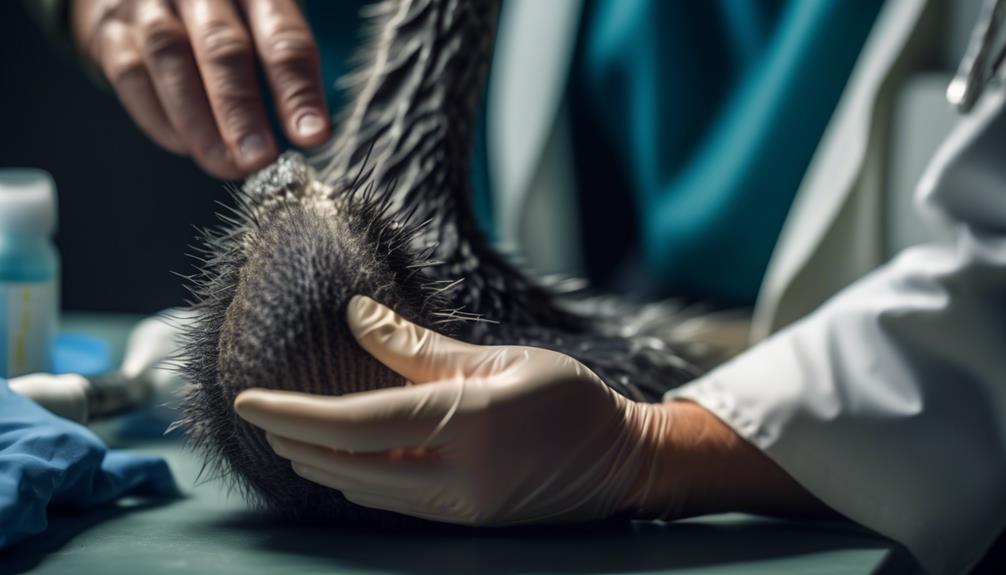
Do you own or care for emus? If so, you may have encountered a common foot problem that affects these fascinating creatures.
Imagine a scenario where one of your emus starts limping and showing signs of discomfort. You're left wondering what could be causing this issue and how you can help alleviate their pain.
In this discussion, we will explore the importance of emu foot health, common foot problems in emus, and provide you with essential tips and treatment options to ensure the well-being of your emus.
By understanding the intricacies of emu foot care, you'll be equipped to provide the necessary care and treatment for any foot-related issues that may arise.
Key Takeaways
- Proper care of emu feet is essential for their overall health and well-being.
- Neglecting foot care can lead to foot infections, lameness, and even death.
- Regular inspections, cleaning, and trimming of nails are necessary to prevent foot problems.
- Recognizing and treating foot health issues promptly can prevent further complications.
Importance of Emu Foot Health
Taking proper care of your emu's feet is of utmost importance to ensure their overall health and well-being. Emu foot health benefits not only the feet themselves, but also the emu's ability to move, forage, and maintain a healthy weight. Neglecting foot care can lead to a variety of issues, including foot infections, lameness, and even death.
To keep your emu's feet in optimal condition, there are several emu foot care tips to follow. First, provide a clean and dry environment for your emu to prevent infections and foot problems. Regularly inspect the feet for any signs of injury, such as cuts or swelling, and treat them promptly.
Trim the nails regularly to prevent overgrowth, which can cause discomfort and affect the emu's gait. Additionally, ensure that the emu has access to a varied diet that includes essential nutrients for strong and healthy feet.
Common Foot Problems in Emus
Properly addressing the importance of emu foot health, it's crucial to understand the common foot problems that can arise in these majestic creatures. Emus are known for their strong and sturdy feet, but they aren't invulnerable to issues.
Here are four common foot problems that emus may experience:
- Bumblefoot: This is a bacterial infection that causes swelling and abscesses on the footpad. It can be caused by rough or contaminated surfaces, leading to pain and discomfort for the emu.
- Cracked skin: Emus are prone to dry and cracked skin on their feet. This can be caused by exposure to harsh weather conditions or lack of proper hydration. Cracked skin can become a breeding ground for bacteria and lead to infections if not treated promptly.
- Overgrown nails: Emus have long and sharp nails, which can grow too long if not trimmed regularly. Overgrown nails can cause discomfort and difficulty in walking, leading to potential injuries.
- Sprained or strained ligaments: Emus are active creatures and can easily sprain or strain their ligaments. This can occur due to sudden movements or accidents. Prompt diagnosis and appropriate treatment are essential to prevent further damage.
When diagnosing foot problems in emus, it's important to handle foot injuries with care. Gentle examination and cleaning of the affected area are crucial, followed by appropriate treatment measures such as bandaging, antibiotic ointments, or trimming of overgrown nails. Seeking veterinary assistance is highly recommended to ensure proper diagnosis and effective treatment.
Recognizing Foot Health Issues

To effectively address foot health issues in emus, it's crucial to recognize the signs and symptoms of potential problems. By being vigilant and observant, you can prevent infections and manage foot pain in these magnificent creatures.
One common foot health issue in emus is foot infections. Look out for signs such as redness, swelling, and discharge from the foot. If you notice any of these symptoms, it's important to take immediate action. Clean the affected area with a mild antiseptic solution and apply an antibiotic ointment to prevent further infection. In severe cases, consult a veterinarian for appropriate treatment.
Another foot health issue that emus may experience is foot pain. Keep an eye out for signs of discomfort such as limping, reluctance to walk, or changes in their gait. If you notice any of these signs, it's crucial to provide appropriate care. Start by inspecting the foot for any visible injuries or abnormalities. Apply a soothing foot balm or cream to alleviate pain and promote healing. If the pain persists or worsens, seek professional veterinary assistance.
Proper Foot Care for Emus
Ensure optimal foot health for emus by implementing a comprehensive foot care regimen. Emu foot anatomy is unique and requires special attention to maintain their overall well-being.
To keep your emus' feet healthy and happy, follow these four essential steps:
- Regular Inspections: Start by examining your emus' feet on a daily basis. Look for any signs of injury, infection, or abnormal growth. Pay close attention to the toenails, as they can become overgrown and cause discomfort. Trimming the nails regularly will prevent issues and ensure proper foot alignment.
- Cleanliness: Emu foot hygiene is crucial to prevent infections. Clean the feet using a mild antiseptic solution or warm soapy water. Gently scrub the feet to remove any dirt, debris, or bacteria that may have accumulated. Rinse thoroughly and pat dry with a clean towel.
- Moisturization: Emus' feet need to stay hydrated to maintain their elasticity and prevent dryness and cracking. Apply a specialized emu foot moisturizer or a natural oil-based product to keep the skin soft and supple. Massage the moisturizer into the feet to promote blood circulation and overall foot health.
- Preventive Measures: Encourage your emus to engage in regular exercise to promote proper foot development and muscle strength. Provide a comfortable and safe environment that minimizes potential foot injuries, such as sharp objects or rough terrain.
Treatment Options for Emu Foot Problems

For treating emu foot problems, a variety of options are available to alleviate discomfort and promote healing. When it comes to treatment options, it's important to consider the severity of the condition and consult with a veterinarian for a proper diagnosis.
One of the most common treatment methods is the use of topical ointments or creams that contain ingredients such as antibiotics, antifungal agents, or corticosteroids. These medications can help reduce inflammation, control infection, and relieve pain.
In more severe cases, oral medications may be prescribed to address underlying causes or systemic issues.
Another treatment option is the use of foot wraps or bandages to provide support and protect the affected area. These wraps can help reduce swelling, provide stability, and promote proper healing.
Additionally, physical therapy techniques such as range of motion exercises, massage, and hydrotherapy can be beneficial in improving blood circulation, reducing inflammation, and enhancing overall foot health.
In certain situations, surgical interventions may be necessary to address specific foot problems such as abscesses, tumors, or fractures.
It's essential to follow the guidance of a veterinarian to ensure the most appropriate and effective treatment plan is implemented for the specific needs of each emu.
Preventive Measures for Foot Health
Implementing proper preventive measures is crucial for maintaining optimal foot health in emus. By taking proactive steps to prevent infections and maintaining proper foot hygiene, you can ensure the well-being of your emu's feet. Here are four important preventive measures to consider:
- Regular cleaning: Emus should have their feet thoroughly cleaned on a regular basis. This involves gently removing any dirt, debris, or feces that may have accumulated. Use a mild antiseptic solution to disinfect the feet and reduce the risk of infections.
- Trimming nails: Emus' nails can grow long and sharp, leading to discomfort and potential injuries. Regularly trim their nails to keep them at a manageable length. Be cautious not to cut too close to the quick, as this can cause bleeding and pain.
- Providing a clean environment: Ensure that the emu's living area is clean and free of sharp objects or rough surfaces that could cause injuries. Regularly clean the floor of their enclosure to prevent the accumulation of bacteria and fungi.
- Regular veterinary check-ups: Schedule regular check-ups with a qualified veterinarian who specializes in avian care. They can examine your emu's feet for any signs of infection or abnormalities and provide appropriate treatment if necessary.
Essential Tools for Foot Care

To properly care for an emu's feet, it's essential to have the right tools at your disposal. Foot care products specifically designed for emus can help ensure the health and well-being of their feet.
One important tool is a hoof trimmer. This tool allows you to safely and effectively trim the emu's nails, preventing overgrowth and potential injury.
Another useful tool is a foot bath. This allows you to clean the emu's feet and prevent the buildup of bacteria or fungi that could lead to infections.
Additionally, a foot file can be used to gently remove any rough or dry skin, keeping the emu's feet smooth and healthy.
When using these tools, it's important to follow proper foot care techniques. This includes cleaning the tools before and after each use to prevent cross-contamination. It's also crucial to handle the emu's feet with care, applying gentle pressure and avoiding any forceful movements that may cause discomfort or injury.
Expert Advice on Emu Foot Health
As you explore the realm of emu foot health, expert advice becomes invaluable in ensuring the well-being of these unique creatures' feet. Here are four important pieces of advice that will help you take preventive measures for foot health and recognize foot health issues:
- Regular Inspections: Conduct regular inspections of your emu's feet to identify any signs of injury, infection, or abnormality. Look for redness, swelling, cuts, or discharge. Any changes in their gait or behavior should also be noted.
- Proper Hygiene: Maintain proper hygiene by keeping the emu's living area clean and dry. Moisture and dirty bedding can lead to bacterial or fungal infections. Regularly clean their feet and apply a gentle antiseptic solution to prevent infections.
- Nail Trimming: Emus have large, sharp nails that require regular trimming. Overgrown nails can cause discomfort and even lead to foot problems. Trim their nails carefully, avoiding the quick, which is the sensitive part of the nail.
- Dietary Considerations: Ensure your emu receives a well-balanced diet rich in essential nutrients. Proper nutrition promotes overall foot health and strengthens their immune system, reducing the risk of foot-related issues.
Frequently Asked Questions
How Long Do Emus Typically Live?
Emus, on average, live for about 10-20 years. However, their lifespan can be affected by various factors such as diet, genetics, and environment. Emus commonly experience foot problems such as bumblefoot and arthritis.
What Is the Average Size of an Emu's Foot?
So you're curious about the average size of an emu's foot? Well, let me tell you, it's not just any ordinary foot. Emu foot anatomy is a fascinating subject, and understanding proper emu foot care techniques is crucial for maintaining their health.
Can Emus Develop Arthritis in Their Feet?
Emus, like any living creature, can develop arthritis in their feet. Signs of arthritis in emus may include limping, swelling, and stiffness. Understanding emu foot anatomy is crucial in providing proper care and treatment.
Are There Any Specific Nutritional Requirements for Maintaining Good Foot Health in Emus?
To maintain good foot health in emus, it is essential to focus on their diet. A balanced and nutrient-rich diet plays a crucial role in preventing foot problems. Additionally, proper foot care techniques should be employed to ensure overall foot health.
Can Emus Wear Shoes or Protective Coverings to Prevent Foot Problems?
Emus cannot wear shoes or protective coverings to prevent foot problems. However, there are alternative options available such as foot wraps or bandages that can provide some level of protection and support for their feet.
Conclusion
In conclusion, maintaining proper foot health is essential for emus to prevent and treat common foot problems. By recognizing foot health issues early and providing proper care, such as regular cleaning and moisturizing, emus can avoid discomfort and potential infections.
Implementing preventive measures, such as keeping their environment clean and providing a balanced diet, can also contribute to their overall foot health.
Just like a well-oiled machine, taking care of emu feet ensures smooth and efficient movement.




